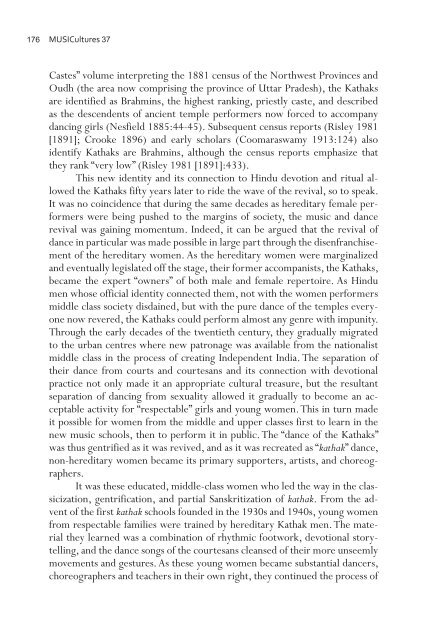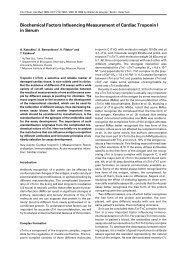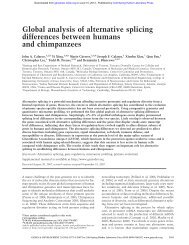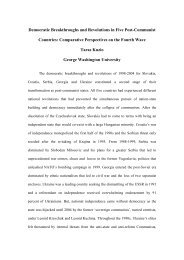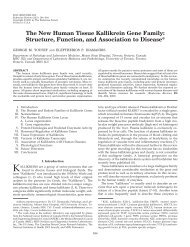revival and reinvention in india's Kathak dance - University of Toronto
revival and reinvention in india's Kathak dance - University of Toronto
revival and reinvention in india's Kathak dance - University of Toronto
Create successful ePaper yourself
Turn your PDF publications into a flip-book with our unique Google optimized e-Paper software.
176 MUSICultures 37Castes” volume <strong>in</strong>terpret<strong>in</strong>g the 1881 census <strong>of</strong> the Northwest Prov<strong>in</strong>ces <strong>and</strong>Oudh (the area now compris<strong>in</strong>g the prov<strong>in</strong>ce <strong>of</strong> Uttar Pradesh), the <strong>Kathak</strong>sare identified as Brahm<strong>in</strong>s, the highest rank<strong>in</strong>g, priestly caste, <strong>and</strong> describedas the descendents <strong>of</strong> ancient temple performers now forced to accompanydanc<strong>in</strong>g girls (Nesfield 1885:44-45). Subsequent census reports (Risley 1981[1891]; Crooke 1896) <strong>and</strong> early scholars (Coomaraswamy 1913:124) alsoidentify <strong>Kathak</strong>s are Brahm<strong>in</strong>s, although the census reports emphasize thatthey rank “very low” (Risley 1981 [1891]:433).This new identity <strong>and</strong> its connection to H<strong>in</strong>du devotion <strong>and</strong> ritual allowedthe <strong>Kathak</strong>s fifty years later to ride the wave <strong>of</strong> the <strong>revival</strong>, so to speak.It was no co<strong>in</strong>cidence that dur<strong>in</strong>g the same decades as hereditary female performerswere be<strong>in</strong>g pushed to the marg<strong>in</strong>s <strong>of</strong> society, the music <strong>and</strong> <strong>dance</strong><strong>revival</strong> was ga<strong>in</strong><strong>in</strong>g momentum. Indeed, it can be argued that the <strong>revival</strong> <strong>of</strong><strong>dance</strong> <strong>in</strong> particular was made possible <strong>in</strong> large part through the disenfranchisement<strong>of</strong> the hereditary women. As the hereditary women were marg<strong>in</strong>alized<strong>and</strong> eventually legislated <strong>of</strong>f the stage, their former accompanists, the <strong>Kathak</strong>s,became the expert “owners” <strong>of</strong> both male <strong>and</strong> female repertoire. As H<strong>in</strong>dumen whose <strong>of</strong>ficial identity connected them, not with the women performersmiddle class society disda<strong>in</strong>ed, but with the pure <strong>dance</strong> <strong>of</strong> the temples everyonenow revered, the <strong>Kathak</strong>s could perform almost any genre with impunity.Through the early decades <strong>of</strong> the twentieth century, they gradually migratedto the urban centres where new patronage was available from the nationalistmiddle class <strong>in</strong> the process <strong>of</strong> creat<strong>in</strong>g Independent India. The separation <strong>of</strong>their <strong>dance</strong> from courts <strong>and</strong> courtesans <strong>and</strong> its connection with devotionalpractice not only made it an appropriate cultural treasure, but the resultantseparation <strong>of</strong> danc<strong>in</strong>g from sexuality allowed it gradually to become an acceptableactivity for “respectable” girls <strong>and</strong> young women. This <strong>in</strong> turn madeit possible for women from the middle <strong>and</strong> upper classes first to learn <strong>in</strong> thenew music schools, then to perform it <strong>in</strong> public. The “<strong>dance</strong> <strong>of</strong> the <strong>Kathak</strong>s”was thus gentrified as it was revived, <strong>and</strong> as it was recreated as “kathak” <strong>dance</strong>,non-hereditary women became its primary supporters, artists, <strong>and</strong> choreographers.It was these educated, middle-class women who led the way <strong>in</strong> the classicization,gentrification, <strong>and</strong> partial Sanskritization <strong>of</strong> kathak. From the advent<strong>of</strong> the first kathak schools founded <strong>in</strong> the 1930s <strong>and</strong> 1940s, young womenfrom respectable families were tra<strong>in</strong>ed by hereditary <strong>Kathak</strong> men. The materialthey learned was a comb<strong>in</strong>ation <strong>of</strong> rhythmic footwork, devotional storytell<strong>in</strong>g,<strong>and</strong> the <strong>dance</strong> songs <strong>of</strong> the courtesans cleansed <strong>of</strong> their more unseemlymovements <strong>and</strong> gestures. As these young women became substantial <strong>dance</strong>rs,choreographers <strong>and</strong> teachers <strong>in</strong> their own right, they cont<strong>in</strong>ued the process <strong>of</strong>


